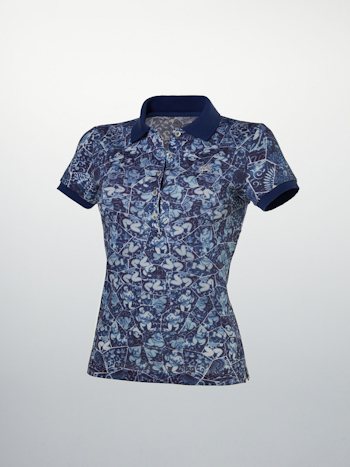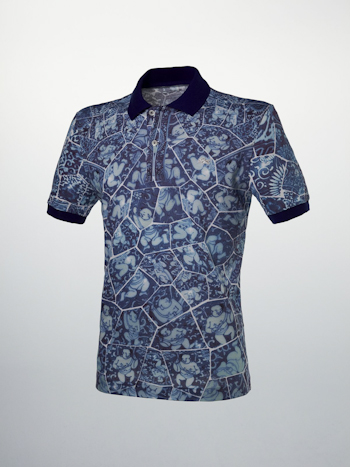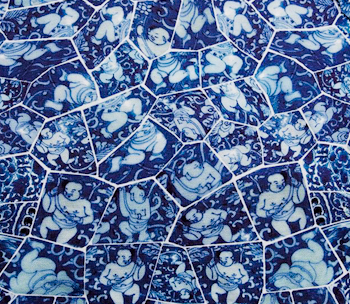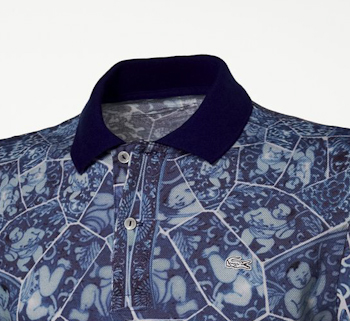In addition to producing the porcelain polo, unlikely to be worn or re-produced, Lacoste asked Li Xiaofeng to design some cotton polos for the Holiday Collector’s Series 2010.
æŽæ™“峰制作的é’花瓷马çƒè¡«è™½è®¾è®¡æ„Ÿå足,但å¯ç©¿æ€§å¹¶ä¸å¼ºã€‚
He came out with two designs, one for men and one for women. Some changes will still be made – Li Xiaofeng says the colors are not quite right – but the print will be the same as what you see here. The final version will be produced in a limited addition of 20,000. The print is based on blue and white shards from the Kangxi Period (1662-1722) of the Qing Dynasty (1644-1912), a time when both China and the art of porcelain production were at their apogee. According to Li Xiaofeng, it was a glorious period for his country, somewhat like the present.
å› æ¤ï¼ŒLacoste希望æŽæ™“峰为他们的2010å¹´å‡æœŸæ”¶è—版设计较为大众的马çƒè¡«ã€‚æŽæ™“峰为男女å„设计了一款,但是他说æ¤æ¬¾è®¾è®¡è¿˜éœ€è¦å¾ˆå¤šçš„修改;尤其是上衣的颜色,但花纹应该会ä¿æŒæˆ‘们所看到的é’花瓷图案。最åŽçš„æˆå“仅会在全çƒç”Ÿäº§20000件。这次马çƒè¡«çš„设计çµæ„Ÿæ¥æºäºŽæ¸…æœï¼ˆ1644 1912)康熙年间(1662-1722)所常è§çš„è“白é’花瓷碎片图案。
This print represents happiness and exuberant youth in the eyes of Li Xiaofeng. Originally the reason for images of babies was to promote the births and good health of children in an era of high infant mortality. Li points out that joy continues exist even in a life that is always faced with difficulites, a life where we must continually reassemble the pieces after setbacks. Li photographed each of the shards and placed them in life-sized digital pattern of each part of the polo.
ä¸å›½çš‡æœä¸Žé’花瓷的生产在这段时间都达到了鼎盛时期。æ®æŽæ™“峰所说,那是ä¸å›½çš„å…‰è£æ—¶æœŸï¼Œå°±åƒçŽ°åœ¨çš„ä¸å›½ä¸€æ ·ã€‚在æŽæ™“峰的眼ä¸ï¼Œè¿™æ ·çš„图案代表幸ç¦ä¸Žæ—ºç››å¹´ã€‚他使用婴儿图片的原始用æ„是为了促进在这个儿童æ»äº¡çŽ‡æžé«˜çš„社会的儿童å¥åº·èŒå£®æˆé•¿ã€‚æŽæŒ‡å‡ºï¼Œæ¬¢ä¹ä¸Žå¹¸ç¦å…¶å®žä¸€ç›´éƒ½å˜åœ¨ä¸Žæˆ‘们的生活,å³ä½¿åœ¨å›°éš¾æ—¶æœŸï¼Œæˆ‘们都必须è¦é¢å¯¹é‚£äº›æŒ«æŠ˜ï¼Œå¹¶åŠªåŠ›çš„寻找身边的幸ç¦ã€‚æŽæ™“峰照下了组æˆè¿™æ¬¾é’花瓷马çƒè¡«çš„æ¯ä¸€å—碎片,并用数å—技术把它们组æˆå®žé™…大å°çš„图案。
Lacoste is using its highest end white crocodile logo for this special edition.
Lacoste在这款特别版马çƒè¡«ä¸Šä½¿ç”¨äº†ä»–们最ç贵的白色鳄鱼图案。




Comments are closed.